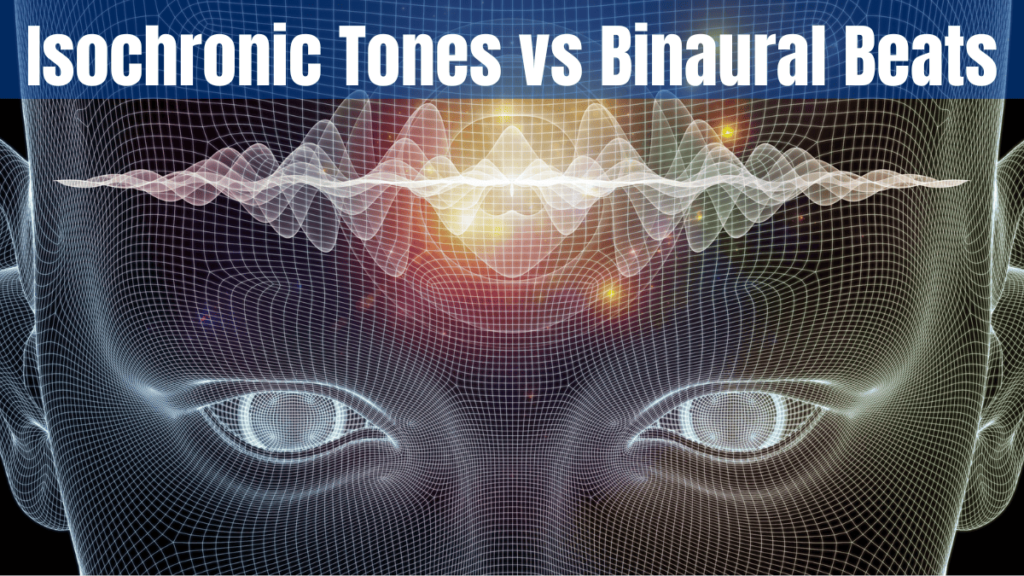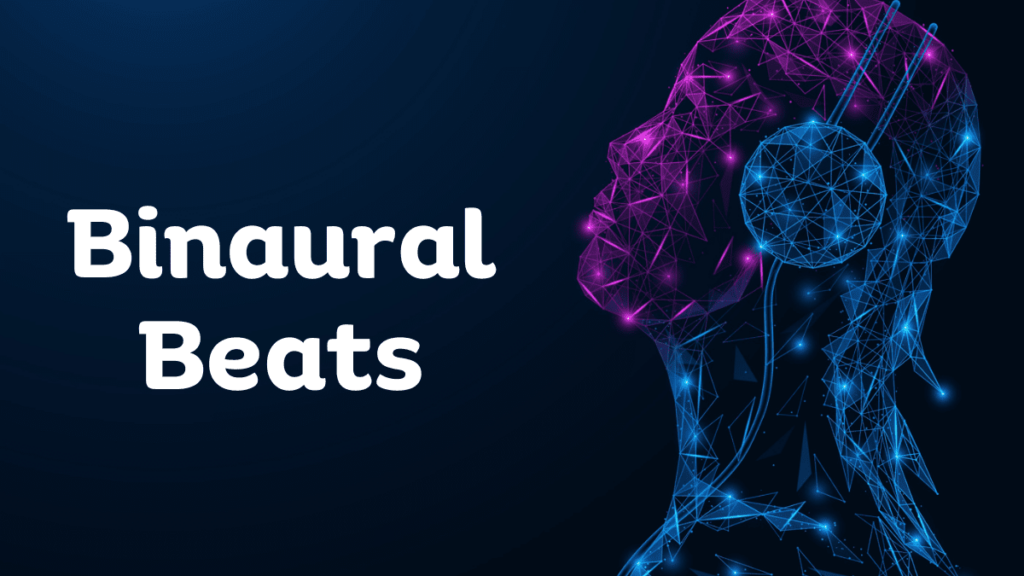Ever found yourself intrigued by the promises of brainwave entrainment but feeling a bit lost in the labyrinth of binaural beats and isochronic tones?
If that’s you, then you’re in the right place! In this article, I’m about to unravel the mysteries and lay bare the distinctions between isochronic tones and binaural beats.
Get ready for a journey into the world of mind-altering sounds as I explore the pros and cons, helping you navigate the landscape of binaural beats and isochronic tones.
It’s your ticket to understanding and optimizing your experience with brainwave entrainment – let’s dive in!

Understanding Brainwave Entrainment
Our brains pulsate with neural activity, generating electromagnetic waves that fall into different frequency ranges tied to various mental states. Think of your alert, focused waking state versus dreaming sleep.
Behind that contrast lies shifts in “brainwaves” produced as billions of neurons activate.
The most common groupings include:
– Beta waves (12-30 Hz) – Associated with normal waking consciousness and an engaged mind
– Alpha waves (8-12 Hz) – Present when relaxation begins; bridges the gap between conscious and subconscious worlds
– Theta waves (4-8 Hz) – Deep relaxation and inward focus; also dominant in light sleep
– Delta waves (0.5-4 Hz) – The slowest waves that mark deep, dreamless sleep
Now what if you could tap into slower alpha and theta waves on command to reach meditative calm or enhance creativity while wide awake?
Or promote restful delta waves to fall asleep faster at night? That transformative ability fuels the benefits of the emerging brainwave entrainment field.
The core technique uses layered audio tones to lull the brain towards specific frequencies.
For example, delivering a 100 Hz tone into the left ear and 108 Hz tone into the right can guide the mind towards an equidistant 8 Hz midpoint in the alpha range.
Resonating like a tuning fork, neural impulses synchronize to the auditory rhythm through a process called frequency following response.
The result for listeners? Think effortlessly slipping into soothing zen-like stillness to relieve stress or laser-focusing concentration levels to plow through complex tasks without distraction or mental fog.
From optimizing sleep to expanding thinking horizons, sound can be an easily-accessible portal for unleashing optimal mental states on demand.
Though individual experiences vary, the science and subjective feedback suggest brainwave entrainment warrants attention.
Are you ready to give it a listen and potentially reap the benefits?
Explaining Binaural Beats
First discovered in 1839, binaural beats represent one of the oldest and most researched forms of brainwave entrainment. They work by broadcasting different Hz tones into each ear to drive the brainstem’s response.
For example, delivering 400 Hz into the left channel and 410 Hz into the right creates an embedded 10 Hz pulse (the difference between the two tones) that resonates through the head. Keeping this below 30 Hz targets brainwaves in the alpha/theta range.
As neural activity synchronizes to tune into that beat, users tap into relaxed or dreamlike meditative states linked to those slower frequency bands. Listening with headphones boosts effectiveness by separating left/right tones.
Benefits include boosting creativity, lowering stress, and easing anxiety. However, some users struggle due to the monotone tones or need for headphones.
Binaural beats also may not impact higher beta/gamma waves for concentration.

Explaining Isochronic Tones
First introduced in the 1980’s, isochronic tones provide another popular modern brainwave entrainment approach. They structure sounds into evenly spaced pulses turning on/off within the chosen frequency range.
For instance, an 8 Hz isochronic tone pulses alpha wave audio on for 0.125 seconds then off for 0.125 seconds continuously like a metronome to pull neural activity into that rhythm.
Users tend to report faster, stronger results thanks to the crisp patterning effect on the brain.
Benefits include mood enhancement, stress relief, and aids for deep sleep or focus when layered into the matching frequency.
However, some users experience fatigue or irritation when auditory stimulation feels too intense. Creative masking as background textures helps counteract this issue.
While outcomes vary individually, both methods have the potential to unlock mental states conducive for decompressing or solving problems based on your needs.
Key Differences Between Isochronic Tones and Binaural Beats
While binaural beats and isochronic tones take slightly different sound-based approaches to achieving brainwave entrainment, how do they compare for real-world use? Here’s an easy-to-scan overview:
| Binaural Beats | Isochronic Tones | |
| Audio Experience | Sweeping drone-like tones | Pulsing on/off robotic beats |
| Effectiveness by Brainwave | Best for Alpha/Theta/Delta | Impacts wider spectrum |
| Optimal Delivery Method | Over headphones | Works over speakers |
| Availability of Recordings | More variety exists | Fewer options, but growing |
Key takeaways
- Binaural beats use a sweeping tonal effect requiring headphones, but excellent for tapping alpha/theta/delta waves
- Isochronic tones utilize more jarring – yet effective – robotic pulsing that works over speakers, flexible for different focus states
In short, binaural beats excel at instilling deep meditative relaxation or helping sleep issues while isochronic tones can target concentration, energy, or creativity on top of chilled out states – no headphones required.
Try sampling both to see what method resonates best based on your needs. Quality recordings help ensure your time invested leads to entrainment success rather than tuning out.
Experimenting With What Works Best For You
When it comes to binaural beats vs isochronic tones for personal use, no universally superior option exists.
Outcomes vary based on individual brains responding differently to the stimuli. What clicks for your coworker may clash for you.
Instead of theorizing, try both technologies armed with quality recordings. Spend at least a week self-testing each method while noting impacts on relaxation, sleep, concentration, creativity or other targets.
Monitor how your mind and body feel before, during and after sessions.
Pay attention to any side effects like headaches or irritation too.
Reflect on your reactions to pick the better pathway for dialing into desired mental states. Cost and availability of sessions may also steer decisions for some users.
Tips for Choosing Recordings: Seek a money-back guarantee, high marks from other buyers, reputable creators who understand neural science, and an audio journey tailored for your goal state.

Enhancing Your Experience
Fine-tuning the context where you use binaural beats or isochronic tones also elevates effectiveness.
Ambient background textures like rainfall pair better with entrainment than blaring metal music. The tones need room to resonate.
Finding a quiet space also helps avoid disruptive distractions hijacking your headspace. In general, allot 15-30 focused minutes for achievable benefits per session before fatigue sets in.
Think “quick reboot break” rather than hours-long grind.
In terms of expectations, each brainwave state lends unique boons:
– **Alpha’s** creative flow for artists or relaxed distressing
– **Theta’s** out-of-box ideas generation or pre-sleep prep
– **Delta’s** deep touch with subconscious insights
Ride the waves where they best serve you by putting science-backed audio tools to work!
Final Thoughts
When it comes to binaural beats vs isochronic tones for brainwave entrainment, no definitive “king” emerges given their differing mechanics and flexible applications.
Yet both modern sound-based technologies offer shortcuts to unlocking beneficial alpha, theta and delta mental patterns linked to lower stress, better sleep, enhanced focus and more based on your needs.
For example, binaural beats can help wind down racing minds to reduce insomnia, while isochronic tones may boost productivity when intense focus is needed.
Key Takeaways:
- Binaural beats play off auditory illusion for sweeping, chill outcomes
- Isochronic tones utilize more intense - yet effective - robotic pulsing
- Results vary individually so test both to see what works best
- Context and quality recordings optimize your experience
Instead of wondering whether binaural or isochronic reigns supreme, embrace the good news that science allows easy access to tap into relaxation and creativity-fostering states with minimal investment or expertise required.
Rather than speculate, why not listen for yourself today?
The direct experience will reveal what works best for you faster than any debate ever could.
Let your personalized trials guide your brain to refreshing new spaces that upgrade work, relationships and beyond!
You may also be interested in: 1. Profound Meditation Program 3.0 2. Zen12 Meditation Program 3. The Raikov Effect [What Is It & How It Works]






